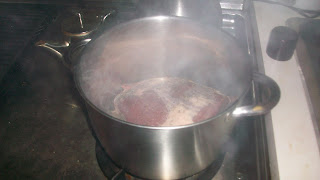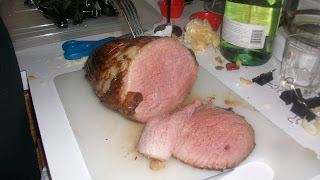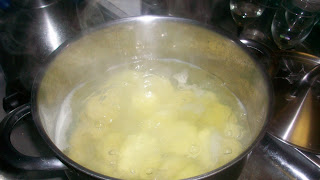Hello again my avid viewing public of six! I know you have probably missed me something awful, but this week was my roommate's birthday and I was very busy pretending that it is reasonable to fit forty people in my apartment to celebrate.
Lucky for you, however, Bridge's birthday lent me the opportunity to expand my culinary vocabulary to include roast beast. Specifically, while we were snowed in over the Snowpocalypse, we watched a lot of cooking shows, and in particular we watched an episode of America's Test Kitchen which featured roast beef salted over a twenty-four hour period and then slow roasted to perfection, and I thought, well I could totally do that.
As the title of the post suggested it all got a lot more complicated. You can find the the whole recipes for the roast and the mashed potatoes here
To the Main Event: Slow Roast Beef!
Serves 6 to 8| 1 | boneless eye-round roast (3 1/2 to 4 1/2 pounds) (see note) |
| 4 | teaspoons kosher salt or 2 teaspoons table salt |
| 2 | teaspoons vegetable oil plus 1 tablespoon |
| 2 | teaspoons ground black pepper |
1. Sprinkle all sides of roast evenly with salt. Wrap with plastic wrap and refrigerate 18 to 24 hours.
OK, here is where I started to get into trouble (I know it's step one, the foreboding of being snarfed from the jump wasn't lost on me.) It turns out that my kitchen doesn't grow plastic wrap naturally, that instead you have to go out and buy it and bring it home, who knew? Anyway I nixed tin foil as an alternative for no concrete reason other than I thought that the roast my turn out tasting metallic (I feel dumber for having typed that.) Anyway, I wound up putting it in a larger freezer bag, pushing the air out, and sealing it tight with binder clips. No, I don't have a picture of this...something about pride.
2. Adjust oven rack to middle position and heat oven to 225 degrees. Pat roast dry with paper towels; rub with 2 teaspoons oil and sprinkle all sides evenly with pepper. Heat remaining tablespoon oil in 12-inch skillet over medium-high heat until starting to smoke. Sear roast until browned on all sides, 3 to 4 minutes per side. Transfer roast to wire rack set in rimmed baking sheet. Roast until meat-probe thermometer or instant-read thermometer inserted into center of roast registers 115 degrees for medium-rare, 1 1/4 to 1 3/4 hours, or 125 degrees for medium, 1 3/4 to 2 1/4 hours.
Here is where I hit snag two through six. First, it turns out I only have Teflon pans, and I don't think I have anything that I could in fairness refer to as a skillet. The only stainless steel crockery I own is a large soup pot. Turns out this was very fortuitous; not only did the soup pot sear it beautifully it created a natural guard against the hot oil and beef fat sputtering out of the pan. Also, something that the Test Kitchen fails to mention is the ridiculous amount of smoke that is emitted from searing which the soup pot, in part, funneled upward to my oven fan (the part that didn't reach the fan went directly into my lungs...happy birthday Bridge, I am now at least two years closer to my last.) In fact, I would recommend a soup pot even if you are fancy enough to own a skillet.


Now the other part of step two started really promising until I took it out after about an hour to check on the temperature and my meat thermometer told me I was already at medium. Before you write the Test Kitchen an angry letter on my behalf, it turns out my meat thermometer is janky. The Test Kitchen vehemently recommends one of those fancy digital ones that has a probe and a wire that stays outside the oven that Alton Brown always assumes people own, and if you have one I too would recommend it, especially over one that is, you know, broken.
3. Turn oven off; leave roast in oven, without opening door, until meat-probe thermometer or instant-read thermometer inserted into center of roast registers 130 degrees for medium-rare or 140 degrees for medium, 30 to 50 minutes longer. Transfer roast to carving board and let rest 15 minutes. Slice meat crosswise as thinly as possible and serve.
Needless to say given my false earlier reading I skipped to this step a little prematurely. The Roast was pretty rare, especially for someone raised to think that all pink needs to be cooked out of meat; but I was assured that for those not raised by Meta or any other old school Irish person, that the meat was great.

The Side Dish: French Mashed Potatoes with Cheese and Garlic
Serves 6
| 2 | pounds Yukon Gold potatoes (4 to 6 medium), peeled, cut into 1/2-inch-thick slices, rinsed well, and drained |
| Table salt |
| 6 | tablespoons unsalted butter |
| 2 | medium garlic cloves , minced or pressed through a garlic press (about 2 teaspoons) |
| 1 - 1 1/2 | cups whole milk |
| 4 | ounces mozzarella cheese , shredded (about 1 cup) (see note) |
| 4 | ounces Gruyère cheese , shredded (about 1 cup) (see note) |
| Ground black pepper |
1. Place potatoes in large saucepan; add water to cover by 1 inch and add 1 tablespoon salt. Partially cover saucepan with lid and bring potatoes to boil over high heat. Reduce heat to medium-low and simmer until potatoes are tender and just break apart when poked with fork, 12 to 17 minutes. Drain potatoes and dry saucepan.
So far so good:

2. Transfer potatoes to food processor; add butter, garlic, and 11/2 teaspoons salt. Pulse until butter is melted and incorporated into potatoes, about ten 1-second pulses. Add 1 cup milk and continue to process until potatoes are smooth and creamy, about 20 seconds, scraping down sides halfway through.
Well this time I got to step two before I screwed the pooch. It may shock you to learn that someone who resorted to a soup pot to sear beef, also doesn't have a food processor. What I do have are two good hands and the grit that the good Lord gave me, so I used a potato masher and a hand mixer and I think it worked out just fine.
3. Return potato mixture to saucepan and set over medium heat. Stir in cheeses, 1 cup at a time, until incorporated. Continue to cook potatoes, stirring vigorously, until cheese is fully melted and mixture is smooth and elastic, 3 to 5 minutes. If mixture is difficult to stir and seems thick, stir in 2 tablespoons milk at a time (up to ½ cup) until potatoes are loose and creamy. Season with salt and pepper. Serve immediately.

Well that is my post for this week. I know I have given you a lot too think about and your arteries a lot to hate and punish you for. I don't actually eat this bad on a regular basis, and I had intended to make a green of some kind to accompany this dish but with my false belief that the beef was slowing turning to ashes before my guests eyes, I thought I had to get a move on and serve...plus no one missed the greens.*
*See happy faces below....Note: Bridge is also happy but as official blogtographer, she reserves the right to not appear in the blog.
